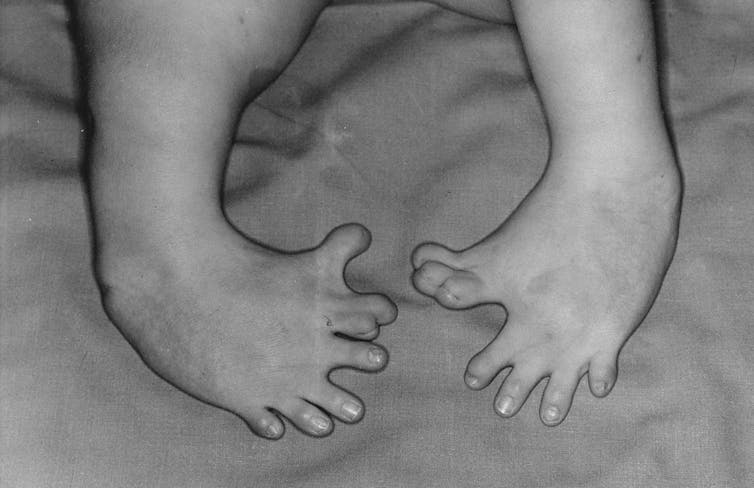 ©
Shutterstock
©
Shutterstock
A doctor friend – let’s call her Anne – was teaching three smart medical students who were told to diagnose a woman complaining of nonspecific pain and anxiety. After 20 minutes of questions, the students wrote seven pages of notes and recommended two drugs: a painkiller and an antidepressant. Anne considered the students’ analysis and agreed that it was based on sound medical evidence. But something told her there was more to the story.
She sat beside the patient, asked general questions and listened carefully. After a few minutes, the woman broke down in tears and told her about a personal tragedy involving a family member. After some comforting, the woman’s tears, shoulder pain and anxiety went away. Anne’s dose of empathy cured the woman, without the need of resorting to drugs. This is an important consideration, given that even relatively mild painkillers may contribute to the opioid crisis as some patients subsequently seek stronger and stronger drugs.
The high value now placed on good empathic communication in medicine is relatively new. Until the 1970s, the doctor-patient relationship was often paternalistic. An anxious patient was less likely to be given a shoulder to cry on and more likely to be given a prescription for Valium (“mother’s little helper”).
In the best enactment of the paternalistic doctor, the fictional surgeon Sir Lancelot Spratt, in the 1969-70 British TV series Doctors in the House, tells a patient who has become distressed at being diagnosed with a serious tumour: “This is nothing whatsoever to do with you.” Colleagues tell me that the scene is an accurate depiction of how things were. At that time, there was little if any communication skills training. Many doctors believed it was an innate skill that could not be taught.
The 1980s saw a change, with the General Medical Council (which set standards for medical doctors in the UK) requiring that communication skills – including empathy – be taught to medical students, and growing recognition in the field that it is an important skill to have.
By the 1990s, communication skills teaching had become a staple of medical school and continuing medical education in the US, Canada and the UK. And within the domain of communication skills, empathy was emerging as a key component.
Certainly, the current focus on good communication hasn’t made the problem of “too much medicine” go away. But promoting empathic communication as a therapeutic agent makes it more likely that people who can do without potentially harmful drugs, like tranquillisers and opioids, don’t get them.
Measuring the effects
We’ve recently quantified the effects of therapeutic empathy the same way drug effects are quantified. More and more carefully controlled trials are comparing what happens with healthcare practitioners who practice empathic, positive communication (being positive is a part of empathy), with those who carry on as usual. The results are overwhelmingly encouraging, with empathic and positive communication improving conditions ranging from lung function and length of hospital stay, to pain, patient satisfaction and quality of life. There is even evidence that it makes the common cold go away faster.
From related research, we also understand more about how positive empathic communication works. First, you need empathy in order to make a correct diagnosis. Without it, patients may not share symptoms, especially embarrassing ones.
Next, an empathic doctor will help put a patient at ease and reduce their stress. Dozens of trials suggest that relaxation reduces pain, depression and anxiety and even lowers the risk of heart disease.
Being positive also activates the patient’s brain in such a way that the patient makes his or her own painkilling endorphins. Empathic positive communication also increases patient satisfaction. Satisfaction, in turn, is correlated with safer and better health outcomes.
By contrast, unfriendly doctors are less likely to get enough information from patients to make the right diagnoses or prescribe the right treatment. One study even showed that unempathic doctors could cause harm by scaring patients away from medical care when they need it.
Like all studies, our review had limitations. For example, the studies in the review were small and mostly “unblinded”. A blind trial is one where the researchers or participants – or both (double-blind) – don’t know which treatment they are getting. Blinding is hard to achieve as doctors know if they have been trained to provide more empathy.
Another limitation is that the effect was small. For example, empathic and positive communication reduced pain by an average of half a point on a ten-point scale. However, this small effect is important, especially if we take harms and drug options into account.
Many commonly used over-the-counter drugs, on the other hand, barely outperform placebos for back pain, cancer pain and many chronic conditions, yet they can have serious side effects. By contrast, a key finding of the study was that positive empathic communication does not seem to harm patients.
 A dose of empathy can even speed recovery from the common cold. RomarioIen/Shutterstock
A dose of empathy can even speed recovery from the common cold. RomarioIen/ShutterstockBefore there was a word for it
It’s been called person-centred care, compassionate care, the Balint method, and Schwarz rounds, among other things. It’s a useful philosophical exercise to disambiguate these terms, and I’m among those who are doing just that. Yet beneath all the apparent differences, they all share the goal of putting care back into healthcare.
In the last two decades, empathy has emerged as the most popular and arguably the most evidence-based of these “caring” therapies. Research on empathy in healthcare is blossoming, with the number of medical journals using the term in research papers increasing tenfold over the last few decades.
The GMC considers empathy to be an essential component of good communication, and there are now training courses on the subject in the US, UK and South Africa.
Yet the word “empathy” is quite new in the English language, first appearing in 1895. It was originally borrowed from the German word “einfülung” and French word “empathie”. It is defined as the ability to understand or appreciate another person’s feelings or experience (“expressive understanding”). In healthcare, it has come to capture the idea of practitioners taking time to understand the patient’s condition, showing they understand, then caring for them. Understanding, communicating and caring all pre-date the word “empathy”.
Throughout the history of medicine, and across cultures, prominent medical practitioners and other smart people have recognised that treating a patient requires more than just dispensing medicine. King Solomon (990—931 BC) wrote: “Pleasant words are a honeycomb, sweet to the soul, and health to the bones” (Proverbs 16:24). Hippocrates (460-370 BC) famously said that “it is more important to know what sort of person has a disease than to know what sort of disease a person has”. Sun Szu-Miao (died 682, known as China’s King of Medicine) instructed doctors: “Commit oneself with great compassion to save every living creature”. Hospice care in medieval times focused on – literally – hospitality for very sick patients.
Empathy got squeezed out as medicine became more professional and scientific. In the 18th century, paternalism wasn’t just normal, it was valued. Patients were expected to unquestioningly do what doctors like Sir Lancelot Spratt told them. The American Medical Association’s first code of ethics (1847) stated:
The obedience of a patient to the prescriptions of his physician should be prompt and implicit. He should never permit his own crude opinions as to their fitness to influence his attention to them.
The paternalistic model faded throughout the 20th century. Sigmund Freud established the importance of psychology, which requires talking to patients in a non-paternalistic way, and in the 1960s Hungarian psychoanalyst Michael Bailint claimed that the “doctor is a drug”, and introduced his training for medical students.
Meanwhile, the thalidomide scandal damaged trust in medicine. From out in left field, Ivan Illich even claimed in the 1970s that medicine did more harm than good. This put patients on a more equal footing with healthcare practitioners and required more mutual understanding. Today, healthcare practitioners in most developed countries couldn’t get away with ignoring patient views, even if they wanted to.
 Baby born to a mother who had taken thalidomide while pregnant. Otis Historical Archives National Museum of Health and Medicine/Wikimedia, CC BY-SA
Baby born to a mother who had taken thalidomide while pregnant. Otis Historical Archives National Museum of Health and Medicine/Wikimedia, CC BY-SAThe move towards empathic communication has been helped by famous medical practitioners, such as Atul Gawande, who writes about the importance of good communication in end-of-life care, and Rana Awdish, who realised how important empathy was when she became a patient.
As strange as it seems to us, paternalism was not as bad as it appears. At the time when paternalism was the norm, “village doctors” lived in their patients’ communities, and knew their patients well. This helped them understand things about the patients that are now being eroded as continuity of care is less common.
Is empathy innate?
Some people still believe that empathic communication – or any communication, for that matter – can’t be taught. Either you are born to be a good empathic communicator, or you are not. Some other practitioners I’ve spoken to believe that all or, at any rate, the vast majority of healthcare practitioners already communicate with empathy. Both those statements are only partly true.
We all know people who have different levels of communication skills. But that doesn’t mean that we can’t improve those skills. In fact, a systematic review of 13 trials (1,466 healthcare practitioners) found that empathic communication can be taught. Practitioners who start off being great communicators probably improved less than those who started off with less “innate” skill. But that doesn’t mean they didn’t improve. Just as Olympic gold medallists still benefit from good coaching, good communicators probably benefit from practice and training.
It’s also only partly true that the great majority of healthcare practitioners already communicate empathy very well. Our latest research found that the extent to which patients feel that their practitioners express empathy varies widely. In our study, we analysed the combined data from 64 published studies on doctor empathy. In the studies, the patients were asked ten questions such as: Does your doctor really listen to you? Did they make you feel at ease? And: Did your doctor put together a helpful plan of action for you? The highest empathy rating is 50.
We found substantial variability. Female practitioners were ranked as more empathic than male practitioners (43/50 versus 35/50), allied health professionals, such as physiotherapists, more empathic than doctors (45/50 versus 40/50), and practitioners from Australia and the US (45/50) being ranked as slightly more empathic than their counterparts in the UK (43/50), Germany (41/50) and China (41/50).
Our research also showed a link between spending more time with patients and greater patient-rated empathy. We don’t know whether spending more time caused more empathy, whether greater empathy caused practitioners to spend time, or whether empathy and more time are inseparable.
Among healthcare practitioners who were rated as less empathic (or who spend less time), it could be that they simply aren’t empathic or don’t want to spend more time with their patients. (Time, after all, is money in many healthcare practices.) But this seeming lack of empathy or willingness to spend more time with patients could be a result of outside pressures.
A recent study found that for every hour spent with patients, doctors spent two hours doing paperwork. That and other system-level factors are leading to burnout and worse care.
It stands to reason that healthcare managers, and society at large, have to be empathic towards healthcare practitioners if we would like them to be empathic towards us. When system-level pressures are a contributing cause of suicide among junior doctors in the UK, society is failing to be empathic towards our healthcare practitioners.
 Allied health professionals are more empathic than doctors, according to one survey. goodluz/Shutterstock
Allied health professionals are more empathic than doctors, according to one survey. goodluz/ShutterstockDismissing the sceptics
Most people believe that empathy in medicine is a good thing, but there are some sceptics. Some worry that too much empathy leads to burnout. And it’s easy to see how this might happen.
A doctor who is always empathic with their patients might actually experience the emotions of all their patients, and this could be draining. Trying to prevent this “compassion fatigue” is one explanation for why empathy seems to decline throughout medical school. Students may learn to protect themselves against that kind of burnout by becoming less empathic. But this only applies if you need to actually experience the emotions of another (this is called “affective empathy”).
Affective empathy is often impossible. For example, I’ll never know what it actually feels like to give birth to a baby. Luckily, you don’t need to actually experience someone else’s emotions to be empathic. I did my best to be empathic to my wife when she was delivering our baby by trying to imagine how much pain and anxiety she was experiencing and doing my best to support her.
Also, some evidence suggests that empathy actually reduces fatigue and burnout. Meanwhile, where it might be a risk factor for fatigue or burnout, good leadership is needed to prevent it, and there is some evidence that mindfulness may mitigate the extra fatigue caused by empathy. Moreover, empathic care improves patient satisfaction, reduces the risk of being sued for medical malpractice and thus removes a major source of stress.
Some people also claim that we don’t need empathy in really important cases. If you get into a serious car accident, you need a paramedic to do something not stop and ask you how you feel. A patient with advanced stage cancer who wants treatment needs prompt action more than long heart-to-heart chats.
Even with less serious illnesses, some patients don’t really want an empathic doctor – they want paternalism. But since empathy is defined as the ability to understand a patient, I don’t think these cases are against empathy. We can assume that someone who is in a car accident needs a paramedic without talking to them about their feelings. In fact, talking to them in that circumstance would be unempathic. Likewise, for someone who wants to be told what to do, an empathic doctor who understands their patient’s needs will act paternalistically. Forcing empathy on someone is not empathic.
In surgery, and other medical procedures that demand skill, we might only care about the person’s skill. If I need surgery, I want the surgeon with the best track record in that kind of surgery. I don’t care if they are empathic or even if they can talk.
But the decision to have surgery or not often does require an empathic conversation. For example, a conversation I had with my doctor led to me avoiding recommended surgery, saving the NHS thousands of pounds. I even recovered well enough to run a marathon.
Healthcare managers worry that empathy takes more time and is therefore unrealistic in a cash-strapped healthcare system. In fact, we found a link between time spent with patients and empathy. What we don’t know is whether the additional time was cost effective. If the longer consultations lead to reduced medication and fewer hospital admissions, then it could be cost effective. A research team in Southampton, Oxford and Keele is doing more research to investigate this.
More importantly, expressing empathy doesn’t necessarily take more time. Empathic body language – looking at the patient instead of a screen, nodding to acknowledge the patient is heard, and smiling – doesn’t take more time. And one study even showed that when doctors sat beside their patients (empathic body language), as opposed to standing up, patients thought they spent more time although it was the same.
From my research in this field, it is clear that most areas of healthcare (bar those emergency situations) could benefit from being more empathic. But it is also clear that systems need to change so that healthcare practitioners can spend more time on empathy than on paperwork. In the words of the physician William Osler: “The good physician treats the disease; the great physician treats the patient who has the disease.”
Jeremy Howick, Director of the Oxford Empathy Programme, University of Oxford
This article is republished from The Conversation under a Creative Commons license. Read the original article.
What to read next
Integrated care… getting rid of bad care from the bottom up?
Health Services Researcher Gemma Hughes writes about what the House of Commons Health and Social Care Committee's Integrated Care Report adds to the discourse of integrated care, and what remains the same.

